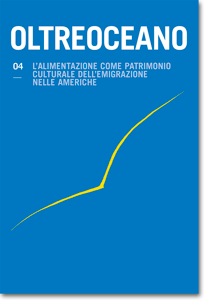«Nespresso! What else?». Appunti sulla storia migratoria della cucina italiana negli USA
Keywords:
ritualità, cibo, emigrazione, Laura Schenone, Simone CinottoAbstract
Lo studio evidenzia la stretta relazione esistente fra la ritualità e l’importanza legate al cibo – e alla sua preparazione – e il processo di assimilazione dell’emigrante nel nuovo paese: un itinerario che dai ghetti dell’emarginazione (o anche, tristemente, delle cosche), conduce, nel tempo, al riconoscimento della propria specificità etnica. Ciò emerge attraverso l’analisi delle opere di Laura Schenone e di Simone Cinotto.
Nespresso! What else? Notes on the Migratory History of Italian Cuisine in the USA
This study highlights the close relationship between rituals, food (including its preparation) and the assimilation of emigrants in the new country. Through an analysis of works by Laura Schenone and Simone Cinotto we trace this itinerary from the ghettos of emigration (or, at times, the gangs) to the acknowledgment over time of one’s specific ethnicity.
Downloads
References
Barolini, H. (1979): Umbertina. New York: Seaview Books.
Cinotto, S. (2001): Una famiglia che mangia insieme. Cibo ed etnicità nella comunità italoamericana di New York, 1920-1940. Torino: Otto.
Cinotto, S. (2003): The Taste of Place: Food in the Narratives of America and Italy by Italian Immigrants of New York, 1920-1950. In M. Bacigalupo & P. Castagneto (Eds.): America and the Mediterranean: Proceedings of the Sixteenth Biennal AISNA International Conference (pp. 145-154). Torino: Otto.
Cinotto, S. (2004): Now That’s Italian!: Representations of Italian Food in American Popular Magazines, 1950-2000. Recuperato in www.italianacademy.columbia.edu/publications/…/paper_sp04_Cinotto.pdf
Covello, L. (1992): The Heart is the Teacher. New York: McGraw-Hill Book Company. Inc. 1958.
Goldmann, A. (1992): Yam What I Yam: Cooking, Culture and Colonialism. In J. Watson & S. Smith (Eds.): De/Colonizing the Subject: The Politics of Gender in Women’s Autobiography (pp. 170-182). Minneapolis: University of Minnesota Press.
Helstosky, C. (2004): Garlic and Oil. Food and Politics in Italy. Oxford: Berg Press.
Hobsbawn, E. & Ranger, T. (1983): The Invention of Tradition. Cambridge: Cambridge UniversityPress.
Ley, D. (1960): A Social Geography of the City. Cambridge: M.I.T. Press.
Puzo, M. (1964): The Fortunate Pilgrim. New York: Random House.
Puzo, M. (1964): The Godfather. New York: G.P. Putnam Sons. 1969.
Schenone, L. (2008): The Lost Ravioli Recipes of Hoboken. A Search for Food and Family. New York, London: W.W. Norton & Company.
Sollors, W. (1989): The Invention of Ethnicity. Oxford: Oxford University Press.
Whitney Peebles, R. (1978): Leonard Covell: a Study of an Immigrant’s Contribution to New York City. New York: Arno Press Inc.
Wurtsbaugh, J. (2000): The Myth and Ritual of Coffee in Mario Puzo’s The Fortunate Pilgrim. Recuperato in mhtml:file//C:Documents and SettingsAsusDocumentiCIBO LETTERATURATh
Downloads
Published
How to Cite
Issue
Section
License

This work is licensed under a Creative Commons Attribution-NonCommercial-ShareAlike 4.0 International License.
The authors undertake to comply with the following conditions, which are considered accepted at the time of submission of their contributions.
The sending of a text implies that it is unpublished and not submitted to be published elsewhere.
1. If accepted, the author shall confer on the publisher the right to publish and distribute it both in paper form and in the online electronic edition. The published articles will be downloadable and made available in open access.
2. Provided that it correctly indicates that the first publication took place in the journal Oltreoceano. Rivista sulle migrazioni the author has the right to: a) reproduce the article in separate extracts or collected in a volume; b) publish the article on their personal website or teaching site provided that these sites are of a non-commercial nature; c) deposit the article in online archives of a non-commercial nature, linked to the institution they belong to or as part of projects for the non-commercial dissemination and open access of scientific works.
The use of contributions by third parties, for commercial or otherwise unauthorized purposes, is not allowed. The publisher declines all responsibility for the unauthorized use of the material published in the journal.












